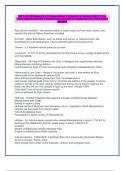HIST 151 UH Manoa Ch. 1-5 Midterm/Exam 1 | Questions & Answers (100 %Score)
Latest Updated 2024/2025 Comprehensive Questions A+ Graded Answers | With Expert
Solutions
Agricultural revolution - the transformation to basic crops such as maze, beans, and
squash that altered Native American societies
Animism - Belief that objects, such as plants and stones, or natural events, like
thunderstorms and earthquakes, have a discrete spirit and conscious life.
Chariot - a 2-wheeled vehicle pulled by a horse
Cuneiform - A form of writing developed by the Sumerians using a wedge shaped stylus
and clay tablets.
Gilgamesh - 5th king of Sumerian city Uruk, a demigod with superhuman strength
Mesopotamian mythology/folklore
Constructed city walls of Uruk and several cities' temples to Mesopotamian cities
Hammurabi's Law Code - History's first known law code, it was written by King
Hammurabi in the eighteenth century BCE
More efficient/predictable government than his predecessors
Hammurabi claimed gods chose him to "promote the welfare of the people, to cause
justice to prevail in the land, destroy wicked and evil so strong doesn't oppress the
weak, rise like the sun over people to light up the land" (Harper 1904)
Code didn't treat all social classes equally
Less punishment for high classes
Hebrews - Earliest Hebrews were pastoral nomads, inhabited lands between
Mesopotamia and Egypt
Settles in region's cities
Hebrew patriarch Abraham from Sumerian city Ur, migrated to North Mesopotamia
Hebrew law borrowed from Hammurabi's
Told of devastating flood
Participated in larger society of Mesopotamia
Hittities - An Indo-European people who entered Mesopotamia in about 1,750 B.C.E.;
destroyed the Babylonian Empire; swept away in about 1,200 B.C.E.
Invaders
Wealth of Babylonian empire attracted them
Empire crumbled before Hittite assaults
Indo-Europeans - 1500s BCE, migrating tribes from present-day Southeast Russia
Some to Europe, Persia, India
Many people there share some linguistic, cultural, and biological roots
, Israelites - 1300 BCE, Hebrews departed under the leadership of Moses and returned to
Palestine, abandoned inherited tribal structure for Mesopotamian-style monarchy
Entered into diplomatic/commercial relations of Mesopotamians, Egyptians, and
Arabians
Mesopotamia - "Land between the rivers", one of the four river-valley regions, ancient
civilizations established
Patriarchy - A form of social organization in which males dominate females
Phoenician - Semitic-speaking people, lived between Mediterranean Sea and Lebanon
Mountains, 3000 BCE established Tyre, Sidon, Beirut, and Byblos
1200-800 BCE dominated Med. trade and established colonies
Byblos (bible), made books from papyrus
Alphabet became basis for Greek and Roman alphabet
Matriarchy - A form of social organization in which females dominate males
Monotheism - Belief in one god (Judaism, Christianity, Islam)
Polytheism - Belief in many gods
Neolithic Era - The New Stone Age; when people learned to make fire and tools such as
saws and drills
Tools for cultivation/sustenance
Economic/social/political changes when domestication of plants and animals
Formed agricultural communities
Women with plants, men with animals
Permanent villages and adopted new forms of social organizations
Paleolithic Era - The Old Stone Age (from 10,000 to 2.5 million years ago); they were
concerned with food supply; they used stone as well as bone tools; they were nomadic
hunters and gatherers.
Homo-sapiens, direct ancestor to Homo sapiens sapiens
Evolved around 200 thousand years ago, established communities, hunting and
gathering, etc.
Reliance on foraging characterizes Old Stone Age
Mobility for search for food, no private property, social equality (egalitarian), no
supremacy
Semitic - People who speak a Semitic language (Akkadian, Hebrew, Aramaic, and
Phoenician)
Sumer(ians) - The people who dominated southern Mesopotamia through the end of the
third millennium B.C.E. They were responsible for the creation of many fundamental




